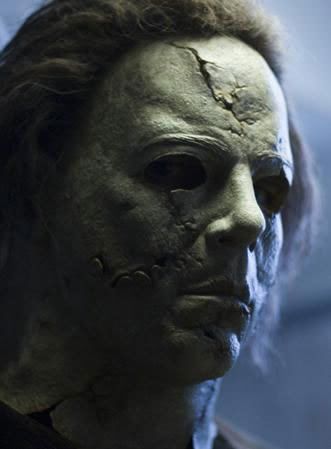A common characterization is that Michael Myers is evil. John Carpenter has described the character as "almost a supernatural force - a force of nature. An evil force that's loose," a force that is "unkillable"Professor Nicholas Rogers elaborates, "Myers is depicted as a mythic, elusive bogeyman, one of superhuman strength who cannot be killed by bullets, stab wounds, or fire." Carpenter's inspiration for the "evil" that Michael would embody came when he was in college. While on a class trip at a mental institution in Kentucky, Carpenter visited "the most serious, mentally ill patients".

Among those patients was a young boy around twelve to thirteen years-old. The boy gave this "schizophrenic stare", "a real evil stare", which Carpenter found "unsettling", "creepy", and "completely insane". Carpenter's experience would inspire the characterization Loomis would give of Michael to Sheriff Brackett in the original film. Debra Hill has stated the scene where Michael kills the Wallace's German Shepherd was done to illustrate how he is "really evil and deadly".

Among those patients was a young boy around twelve to thirteen years-old. The boy gave this "schizophrenic stare", "a real evil stare", which Carpenter found "unsettling", "creepy", and "completely insane". Carpenter's experience would inspire the characterization Loomis would give of Michael to Sheriff Brackett in the original film. Debra Hill has stated the scene where Michael kills the Wallace's German Shepherd was done to illustrate how he is "really evil and deadly".
Describing aspects of Michael Myers which he wanted to explore in the comic book Halloween: Nightdance, writer Stefan Hutchinson mentions the character's "bizarre and dark sense of humor", as seen when he wore a sheet over his head to trick a girl into thinking he was her boyfriend, and the satisfaction he gets from scaring the characters before he murders them, such as letting Laurie know he is stalking her. Hutchinson feels there is a perverse nature to Michael's actions: "see the difference between how he watches and pursues women to men". Nightdance artist Tim Seeley describes the character's original personality—his personality in John Carpenter's 1978 film—as "a void", which allows the character to be more open to interpretation than the later sequels alloted him. He surmises that Michael embodies a part of everyone; a part people are afraid will one day "snap and knife someone", which lends to the fear that Michael creates on screen.

A study was conducted by California State University's Media Psychology Lab, on the psychological appeal of movie monsters—Vampires, Freddy Krueger, Frankenstein's monster, Jason Voorhees, Godzilla, Chucky, Hannibal Lecter, King Kong, and The Alien—which surveyed 1,166 people nationwide (United States), with ages ranging from 16 to 91. It was published in the Journal of Media Psychology. In the survey, Michael was considered to be the "embodiment of pure evil"; when compared to the other characters, Michael Myers was rated the highest. Michael was characterized lending to the understanding of insanity, being ranked second to Hannibal Lecter in this category; he also placed first as the character who shows audiences the "dark side of human nature". He was rated second in the category "monster enjoys killing" by the participants, and believed to have "superhuman strength". Michael was rated highest among the characters in the "monster is an outcast" category






![[01162010825.jpg]](https://blogger.googleusercontent.com/img/b/R29vZ2xl/AVvXsEgYQDKJLOF0ltpy7pUqS0aIZN4Qz0msjSY5TuT17HtNF5l2CHoH_nD3RisaQyC-LuFraITbtrF-h1H4irenjz4M59RheCCsXoxEFRJosPv4L0iuJH_t7-fBj3fe-4COK5c-GE-bNWKfY3DG/s220/01162010825.jpg)



![[butterfriend.jpg]](https://blogger.googleusercontent.com/img/b/R29vZ2xl/AVvXsEiSAYSHoJRFb68lGNDSSL_A0BkqonAj7iCpGEfy56DXmqCFtXCi-7-s76NAV8TW1w38G2bjZCLvdlf9AodCA7AnzrCYrZZS51SxlbARiHaBWxIkYZ_4Y2fqycgqmw6dyWpNECApGAbgleey/s220/butterfriend.jpg)
![[Copy+of+Tekkaus-Thumbnail+new+Large.jpg]](https://blogger.googleusercontent.com/img/b/R29vZ2xl/AVvXsEh2A0iapNYYs722KK3yPo7UfbE4XQw12Hw2iwFxzLRRFOt1Z3xvHr7p9KS_AII4k178CkQm3jzd9g0xX6XV916YtksxoSarlTTd_LKw9e3VbsRBGo_9hUnIg8qh7GVuaF-LLzGmojJ8QGa4/s220/Copy+of+Tekkaus-Thumbnail+new+Large.jpg)




Congrats to Michael Myers for being this week's Rogue of the Week. http://bit.ly/dwQIc6
ReplyDelete